Sports Intellectual Property Law: Tattoo Copyright in the UK
VerifiedAdded on 2022/11/26
|20
|6060
|234
Essay
AI Summary
This essay examines the intersection of sports intellectual property law and copyright, focusing on the unique challenges posed by tattoos and body art. It delves into the legal framework of the United Kingdom, exploring the Copyright, Designs and Patents Act and its implications for the ownership and protection of tattoo designs. The essay discusses the meaning of copyright, historical context of tattoos, trademark issues, publicity rights, and moral rights, providing a comprehensive overview of the legal issues. It analyzes whether tattoos are eligible for copyright protection, considering originality, authorship, and infringement. The essay further investigates the complexities surrounding the use of tattoos on athletes, their image rights, and potential conflicts with trademark law. The author argues for the protection of certain body art and tattoos under UK copyright law and concludes with a summary of the key arguments and implications for athletes and artists.
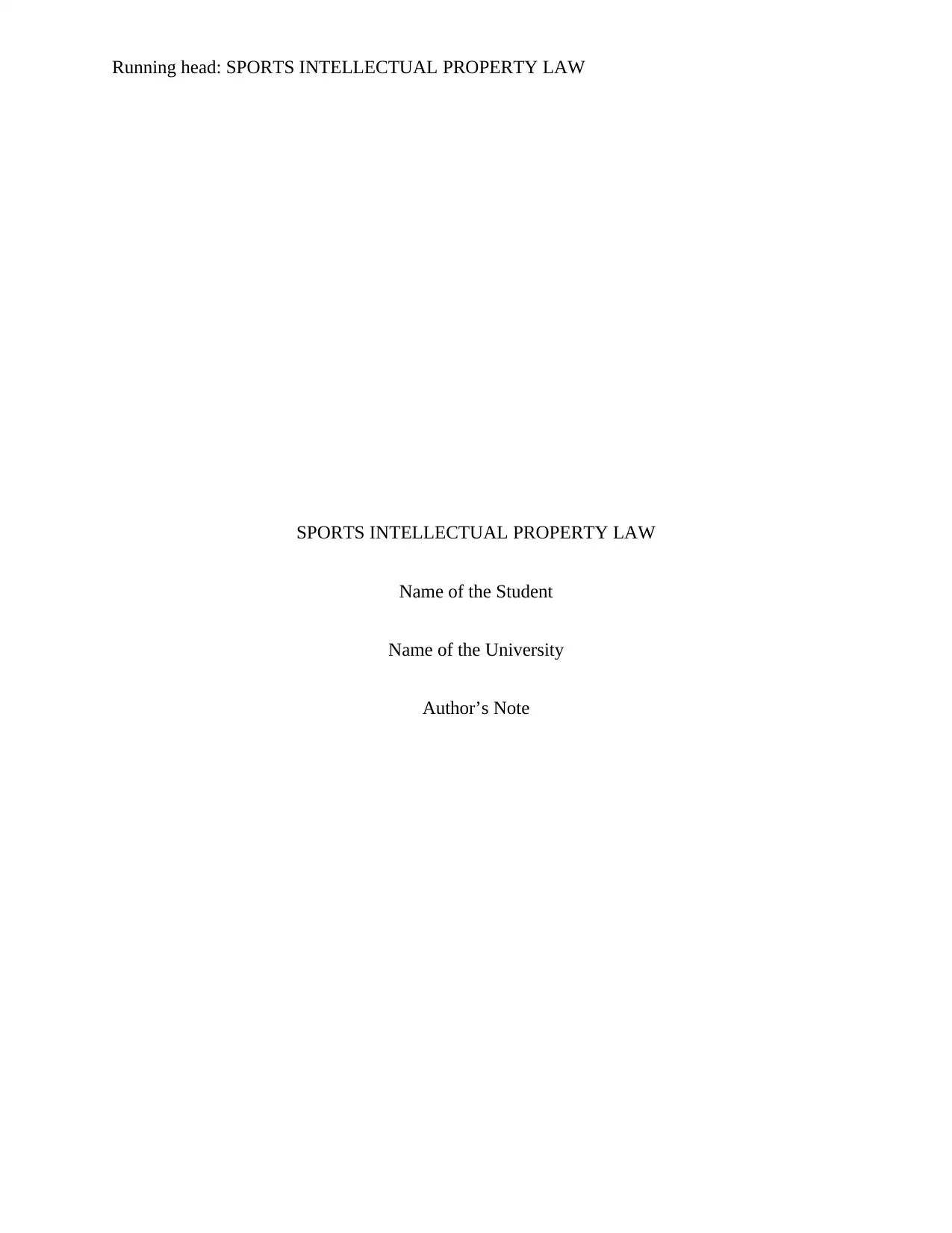
Running head: SPORTS INTELLECTUAL PROPERTY LAW
SPORTS INTELLECTUAL PROPERTY LAW
Name of the Student
Name of the University
Author’s Note
SPORTS INTELLECTUAL PROPERTY LAW
Name of the Student
Name of the University
Author’s Note
Paraphrase This Document
Need a fresh take? Get an instant paraphrase of this document with our AI Paraphraser
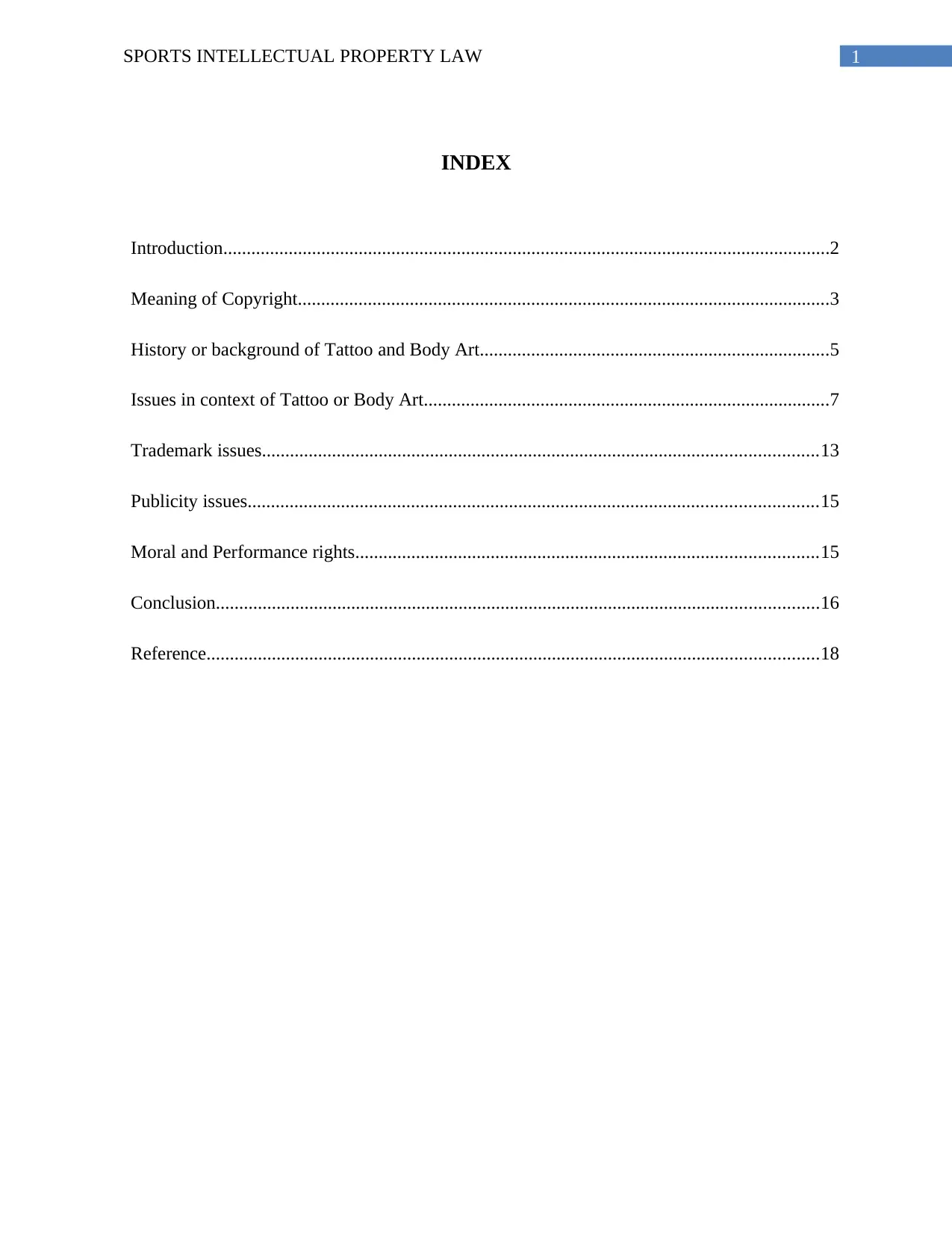
1SPORTS INTELLECTUAL PROPERTY LAW
INDEX
Introduction..................................................................................................................................2
Meaning of Copyright..................................................................................................................3
History or background of Tattoo and Body Art...........................................................................5
Issues in context of Tattoo or Body Art.......................................................................................7
Trademark issues.......................................................................................................................13
Publicity issues..........................................................................................................................15
Moral and Performance rights...................................................................................................15
Conclusion.................................................................................................................................16
Reference...................................................................................................................................18
INDEX
Introduction..................................................................................................................................2
Meaning of Copyright..................................................................................................................3
History or background of Tattoo and Body Art...........................................................................5
Issues in context of Tattoo or Body Art.......................................................................................7
Trademark issues.......................................................................................................................13
Publicity issues..........................................................................................................................15
Moral and Performance rights...................................................................................................15
Conclusion.................................................................................................................................16
Reference...................................................................................................................................18
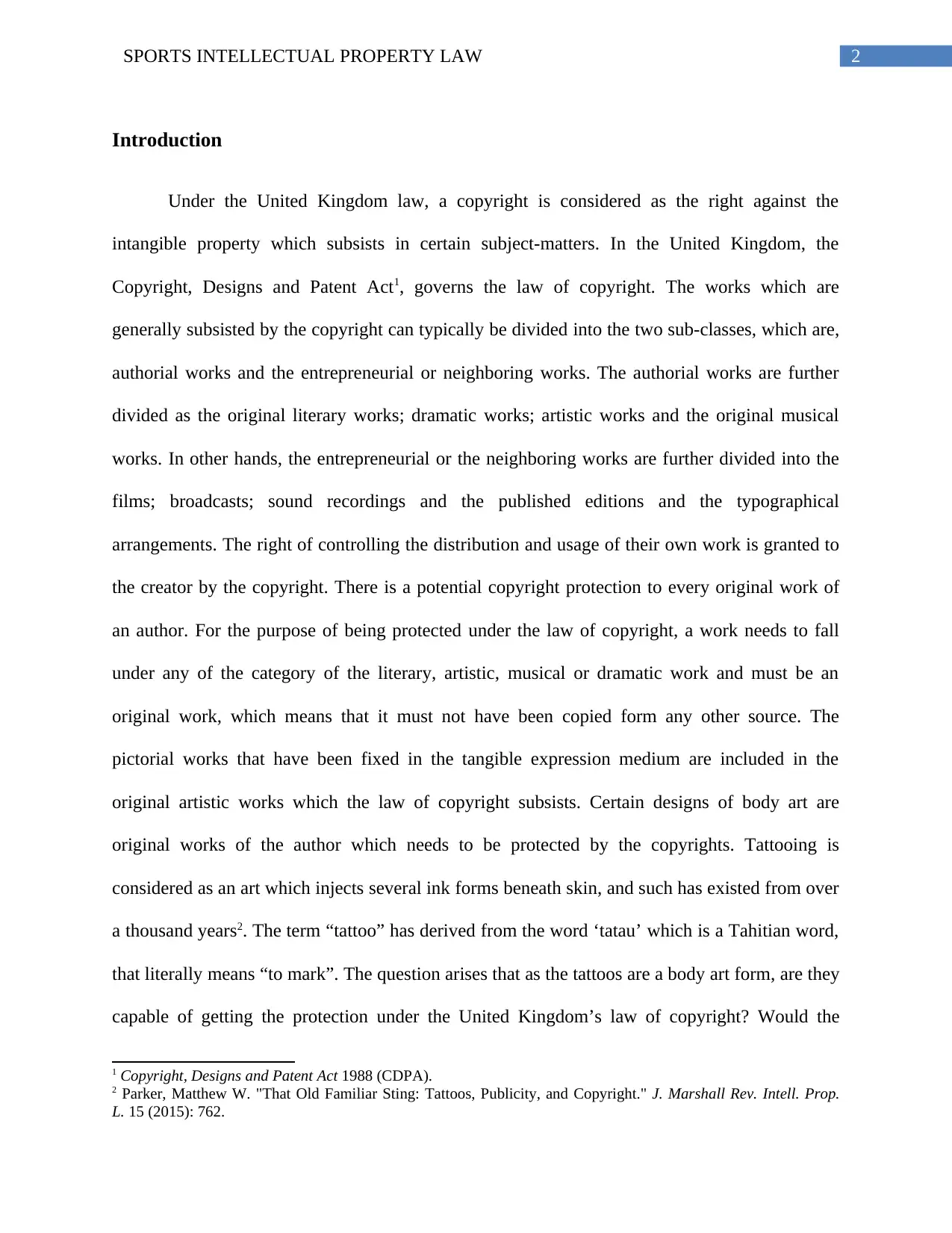
2SPORTS INTELLECTUAL PROPERTY LAW
Introduction
Under the United Kingdom law, a copyright is considered as the right against the
intangible property which subsists in certain subject-matters. In the United Kingdom, the
Copyright, Designs and Patent Act1, governs the law of copyright. The works which are
generally subsisted by the copyright can typically be divided into the two sub-classes, which are,
authorial works and the entrepreneurial or neighboring works. The authorial works are further
divided as the original literary works; dramatic works; artistic works and the original musical
works. In other hands, the entrepreneurial or the neighboring works are further divided into the
films; broadcasts; sound recordings and the published editions and the typographical
arrangements. The right of controlling the distribution and usage of their own work is granted to
the creator by the copyright. There is a potential copyright protection to every original work of
an author. For the purpose of being protected under the law of copyright, a work needs to fall
under any of the category of the literary, artistic, musical or dramatic work and must be an
original work, which means that it must not have been copied form any other source. The
pictorial works that have been fixed in the tangible expression medium are included in the
original artistic works which the law of copyright subsists. Certain designs of body art are
original works of the author which needs to be protected by the copyrights. Tattooing is
considered as an art which injects several ink forms beneath skin, and such has existed from over
a thousand years2. The term “tattoo” has derived from the word ‘tatau’ which is a Tahitian word,
that literally means “to mark”. The question arises that as the tattoos are a body art form, are they
capable of getting the protection under the United Kingdom’s law of copyright? Would the
1 Copyright, Designs and Patent Act 1988 (CDPA).
2 Parker, Matthew W. "That Old Familiar Sting: Tattoos, Publicity, and Copyright." J. Marshall Rev. Intell. Prop.
L. 15 (2015): 762.
Introduction
Under the United Kingdom law, a copyright is considered as the right against the
intangible property which subsists in certain subject-matters. In the United Kingdom, the
Copyright, Designs and Patent Act1, governs the law of copyright. The works which are
generally subsisted by the copyright can typically be divided into the two sub-classes, which are,
authorial works and the entrepreneurial or neighboring works. The authorial works are further
divided as the original literary works; dramatic works; artistic works and the original musical
works. In other hands, the entrepreneurial or the neighboring works are further divided into the
films; broadcasts; sound recordings and the published editions and the typographical
arrangements. The right of controlling the distribution and usage of their own work is granted to
the creator by the copyright. There is a potential copyright protection to every original work of
an author. For the purpose of being protected under the law of copyright, a work needs to fall
under any of the category of the literary, artistic, musical or dramatic work and must be an
original work, which means that it must not have been copied form any other source. The
pictorial works that have been fixed in the tangible expression medium are included in the
original artistic works which the law of copyright subsists. Certain designs of body art are
original works of the author which needs to be protected by the copyrights. Tattooing is
considered as an art which injects several ink forms beneath skin, and such has existed from over
a thousand years2. The term “tattoo” has derived from the word ‘tatau’ which is a Tahitian word,
that literally means “to mark”. The question arises that as the tattoos are a body art form, are they
capable of getting the protection under the United Kingdom’s law of copyright? Would the
1 Copyright, Designs and Patent Act 1988 (CDPA).
2 Parker, Matthew W. "That Old Familiar Sting: Tattoos, Publicity, and Copyright." J. Marshall Rev. Intell. Prop.
L. 15 (2015): 762.
⊘ This is a preview!⊘
Do you want full access?
Subscribe today to unlock all pages.

Trusted by 1+ million students worldwide
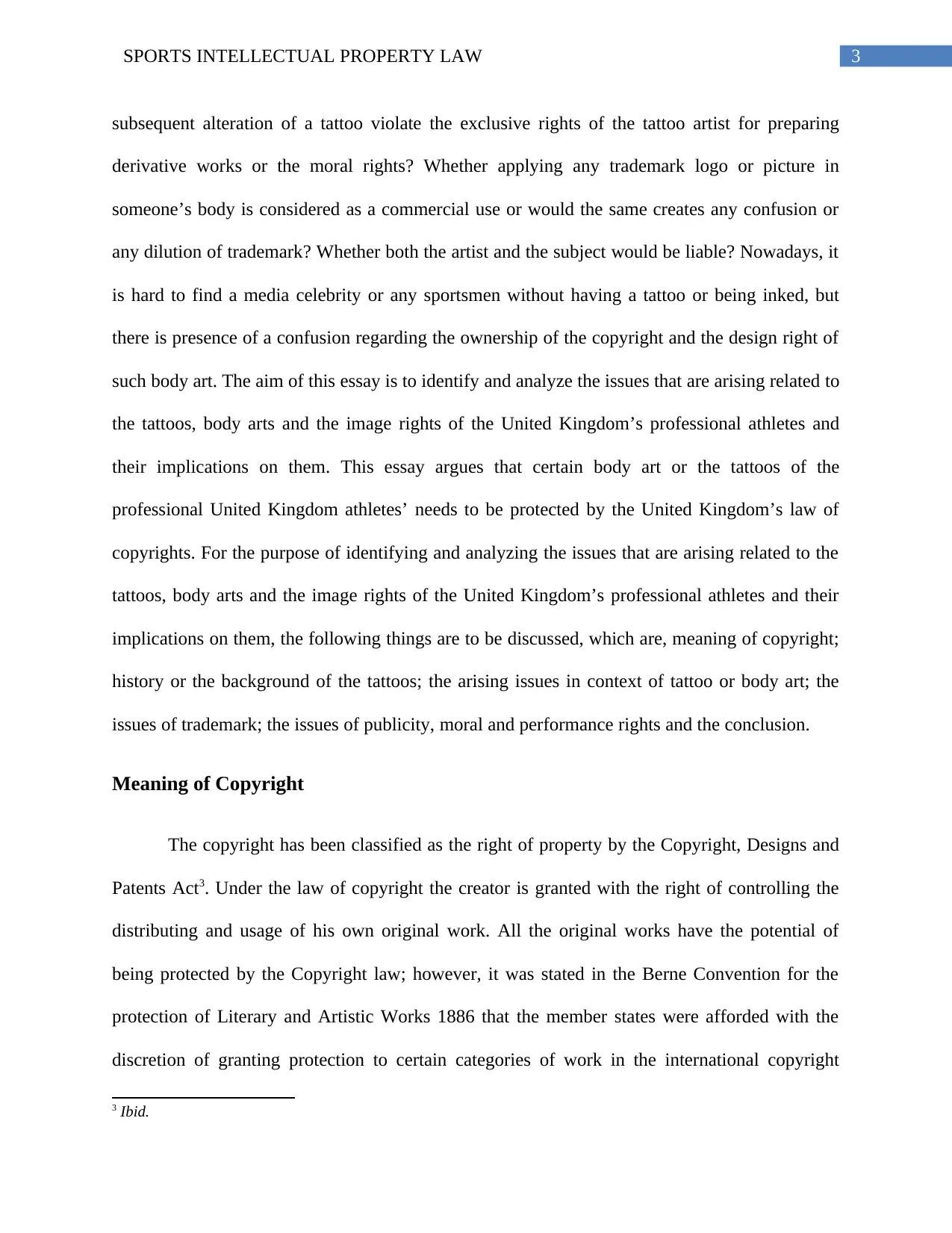
3SPORTS INTELLECTUAL PROPERTY LAW
subsequent alteration of a tattoo violate the exclusive rights of the tattoo artist for preparing
derivative works or the moral rights? Whether applying any trademark logo or picture in
someone’s body is considered as a commercial use or would the same creates any confusion or
any dilution of trademark? Whether both the artist and the subject would be liable? Nowadays, it
is hard to find a media celebrity or any sportsmen without having a tattoo or being inked, but
there is presence of a confusion regarding the ownership of the copyright and the design right of
such body art. The aim of this essay is to identify and analyze the issues that are arising related to
the tattoos, body arts and the image rights of the United Kingdom’s professional athletes and
their implications on them. This essay argues that certain body art or the tattoos of the
professional United Kingdom athletes’ needs to be protected by the United Kingdom’s law of
copyrights. For the purpose of identifying and analyzing the issues that are arising related to the
tattoos, body arts and the image rights of the United Kingdom’s professional athletes and their
implications on them, the following things are to be discussed, which are, meaning of copyright;
history or the background of the tattoos; the arising issues in context of tattoo or body art; the
issues of trademark; the issues of publicity, moral and performance rights and the conclusion.
Meaning of Copyright
The copyright has been classified as the right of property by the Copyright, Designs and
Patents Act3. Under the law of copyright the creator is granted with the right of controlling the
distributing and usage of his own original work. All the original works have the potential of
being protected by the Copyright law; however, it was stated in the Berne Convention for the
protection of Literary and Artistic Works 1886 that the member states were afforded with the
discretion of granting protection to certain categories of work in the international copyright
3 Ibid.
subsequent alteration of a tattoo violate the exclusive rights of the tattoo artist for preparing
derivative works or the moral rights? Whether applying any trademark logo or picture in
someone’s body is considered as a commercial use or would the same creates any confusion or
any dilution of trademark? Whether both the artist and the subject would be liable? Nowadays, it
is hard to find a media celebrity or any sportsmen without having a tattoo or being inked, but
there is presence of a confusion regarding the ownership of the copyright and the design right of
such body art. The aim of this essay is to identify and analyze the issues that are arising related to
the tattoos, body arts and the image rights of the United Kingdom’s professional athletes and
their implications on them. This essay argues that certain body art or the tattoos of the
professional United Kingdom athletes’ needs to be protected by the United Kingdom’s law of
copyrights. For the purpose of identifying and analyzing the issues that are arising related to the
tattoos, body arts and the image rights of the United Kingdom’s professional athletes and their
implications on them, the following things are to be discussed, which are, meaning of copyright;
history or the background of the tattoos; the arising issues in context of tattoo or body art; the
issues of trademark; the issues of publicity, moral and performance rights and the conclusion.
Meaning of Copyright
The copyright has been classified as the right of property by the Copyright, Designs and
Patents Act3. Under the law of copyright the creator is granted with the right of controlling the
distributing and usage of his own original work. All the original works have the potential of
being protected by the Copyright law; however, it was stated in the Berne Convention for the
protection of Literary and Artistic Works 1886 that the member states were afforded with the
discretion of granting protection to certain categories of work in the international copyright
3 Ibid.
Paraphrase This Document
Need a fresh take? Get an instant paraphrase of this document with our AI Paraphraser
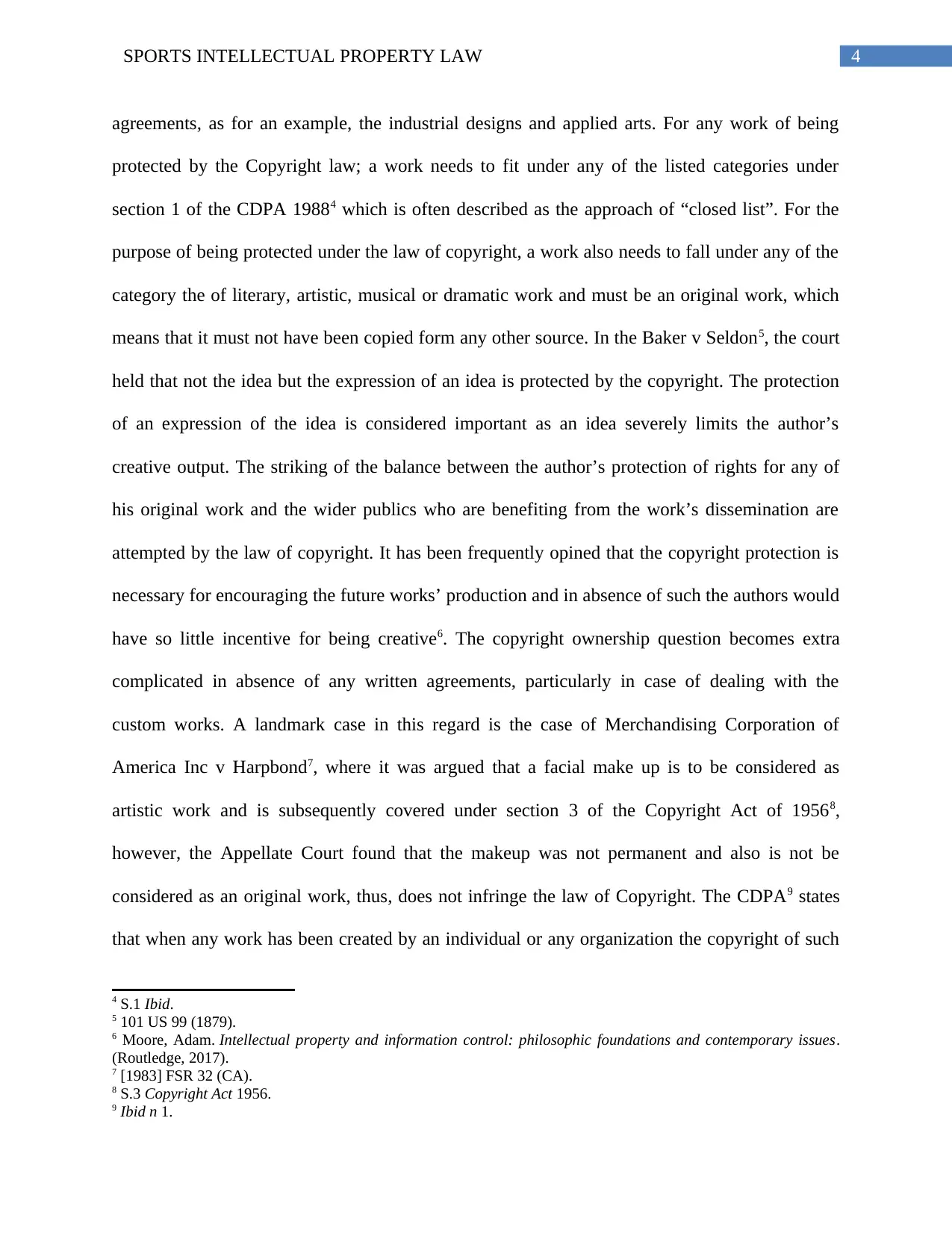
4SPORTS INTELLECTUAL PROPERTY LAW
agreements, as for an example, the industrial designs and applied arts. For any work of being
protected by the Copyright law; a work needs to fit under any of the listed categories under
section 1 of the CDPA 19884 which is often described as the approach of “closed list”. For the
purpose of being protected under the law of copyright, a work also needs to fall under any of the
category the of literary, artistic, musical or dramatic work and must be an original work, which
means that it must not have been copied form any other source. In the Baker v Seldon5, the court
held that not the idea but the expression of an idea is protected by the copyright. The protection
of an expression of the idea is considered important as an idea severely limits the author’s
creative output. The striking of the balance between the author’s protection of rights for any of
his original work and the wider publics who are benefiting from the work’s dissemination are
attempted by the law of copyright. It has been frequently opined that the copyright protection is
necessary for encouraging the future works’ production and in absence of such the authors would
have so little incentive for being creative6. The copyright ownership question becomes extra
complicated in absence of any written agreements, particularly in case of dealing with the
custom works. A landmark case in this regard is the case of Merchandising Corporation of
America Inc v Harpbond7, where it was argued that a facial make up is to be considered as
artistic work and is subsequently covered under section 3 of the Copyright Act of 19568,
however, the Appellate Court found that the makeup was not permanent and also is not be
considered as an original work, thus, does not infringe the law of Copyright. The CDPA9 states
that when any work has been created by an individual or any organization the copyright of such
4 S.1 Ibid.
5 101 US 99 (1879).
6 Moore, Adam. Intellectual property and information control: philosophic foundations and contemporary issues.
(Routledge, 2017).
7 [1983] FSR 32 (CA).
8 S.3 Copyright Act 1956.
9 Ibid n 1.
agreements, as for an example, the industrial designs and applied arts. For any work of being
protected by the Copyright law; a work needs to fit under any of the listed categories under
section 1 of the CDPA 19884 which is often described as the approach of “closed list”. For the
purpose of being protected under the law of copyright, a work also needs to fall under any of the
category the of literary, artistic, musical or dramatic work and must be an original work, which
means that it must not have been copied form any other source. In the Baker v Seldon5, the court
held that not the idea but the expression of an idea is protected by the copyright. The protection
of an expression of the idea is considered important as an idea severely limits the author’s
creative output. The striking of the balance between the author’s protection of rights for any of
his original work and the wider publics who are benefiting from the work’s dissemination are
attempted by the law of copyright. It has been frequently opined that the copyright protection is
necessary for encouraging the future works’ production and in absence of such the authors would
have so little incentive for being creative6. The copyright ownership question becomes extra
complicated in absence of any written agreements, particularly in case of dealing with the
custom works. A landmark case in this regard is the case of Merchandising Corporation of
America Inc v Harpbond7, where it was argued that a facial make up is to be considered as
artistic work and is subsequently covered under section 3 of the Copyright Act of 19568,
however, the Appellate Court found that the makeup was not permanent and also is not be
considered as an original work, thus, does not infringe the law of Copyright. The CDPA9 states
that when any work has been created by an individual or any organization the copyright of such
4 S.1 Ibid.
5 101 US 99 (1879).
6 Moore, Adam. Intellectual property and information control: philosophic foundations and contemporary issues.
(Routledge, 2017).
7 [1983] FSR 32 (CA).
8 S.3 Copyright Act 1956.
9 Ibid n 1.
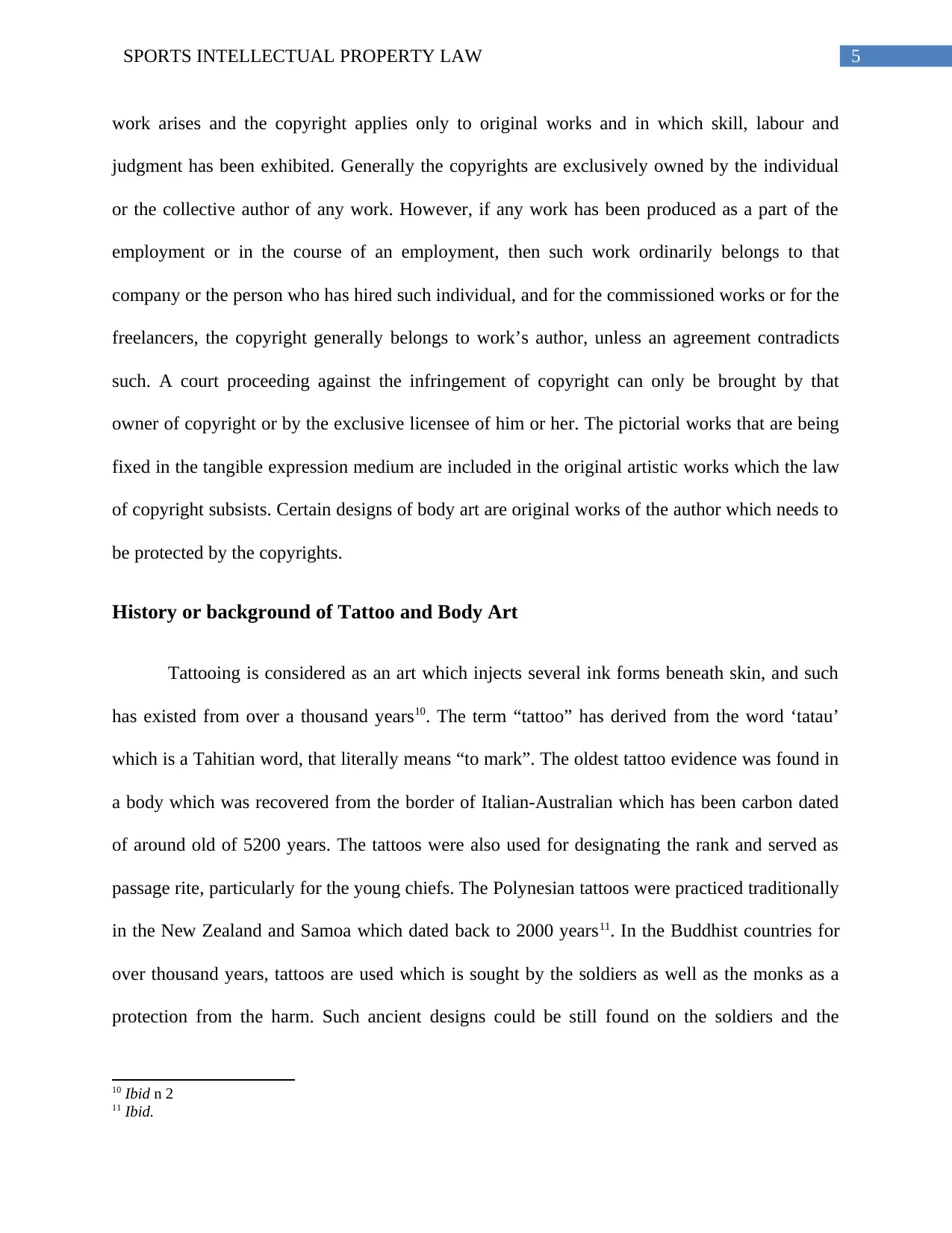
5SPORTS INTELLECTUAL PROPERTY LAW
work arises and the copyright applies only to original works and in which skill, labour and
judgment has been exhibited. Generally the copyrights are exclusively owned by the individual
or the collective author of any work. However, if any work has been produced as a part of the
employment or in the course of an employment, then such work ordinarily belongs to that
company or the person who has hired such individual, and for the commissioned works or for the
freelancers, the copyright generally belongs to work’s author, unless an agreement contradicts
such. A court proceeding against the infringement of copyright can only be brought by that
owner of copyright or by the exclusive licensee of him or her. The pictorial works that are being
fixed in the tangible expression medium are included in the original artistic works which the law
of copyright subsists. Certain designs of body art are original works of the author which needs to
be protected by the copyrights.
History or background of Tattoo and Body Art
Tattooing is considered as an art which injects several ink forms beneath skin, and such
has existed from over a thousand years10. The term “tattoo” has derived from the word ‘tatau’
which is a Tahitian word, that literally means “to mark”. The oldest tattoo evidence was found in
a body which was recovered from the border of Italian-Australian which has been carbon dated
of around old of 5200 years. The tattoos were also used for designating the rank and served as
passage rite, particularly for the young chiefs. The Polynesian tattoos were practiced traditionally
in the New Zealand and Samoa which dated back to 2000 years11. In the Buddhist countries for
over thousand years, tattoos are used which is sought by the soldiers as well as the monks as a
protection from the harm. Such ancient designs could be still found on the soldiers and the
10 Ibid n 2
11 Ibid.
work arises and the copyright applies only to original works and in which skill, labour and
judgment has been exhibited. Generally the copyrights are exclusively owned by the individual
or the collective author of any work. However, if any work has been produced as a part of the
employment or in the course of an employment, then such work ordinarily belongs to that
company or the person who has hired such individual, and for the commissioned works or for the
freelancers, the copyright generally belongs to work’s author, unless an agreement contradicts
such. A court proceeding against the infringement of copyright can only be brought by that
owner of copyright or by the exclusive licensee of him or her. The pictorial works that are being
fixed in the tangible expression medium are included in the original artistic works which the law
of copyright subsists. Certain designs of body art are original works of the author which needs to
be protected by the copyrights.
History or background of Tattoo and Body Art
Tattooing is considered as an art which injects several ink forms beneath skin, and such
has existed from over a thousand years10. The term “tattoo” has derived from the word ‘tatau’
which is a Tahitian word, that literally means “to mark”. The oldest tattoo evidence was found in
a body which was recovered from the border of Italian-Australian which has been carbon dated
of around old of 5200 years. The tattoos were also used for designating the rank and served as
passage rite, particularly for the young chiefs. The Polynesian tattoos were practiced traditionally
in the New Zealand and Samoa which dated back to 2000 years11. In the Buddhist countries for
over thousand years, tattoos are used which is sought by the soldiers as well as the monks as a
protection from the harm. Such ancient designs could be still found on the soldiers and the
10 Ibid n 2
11 Ibid.
⊘ This is a preview!⊘
Do you want full access?
Subscribe today to unlock all pages.

Trusted by 1+ million students worldwide
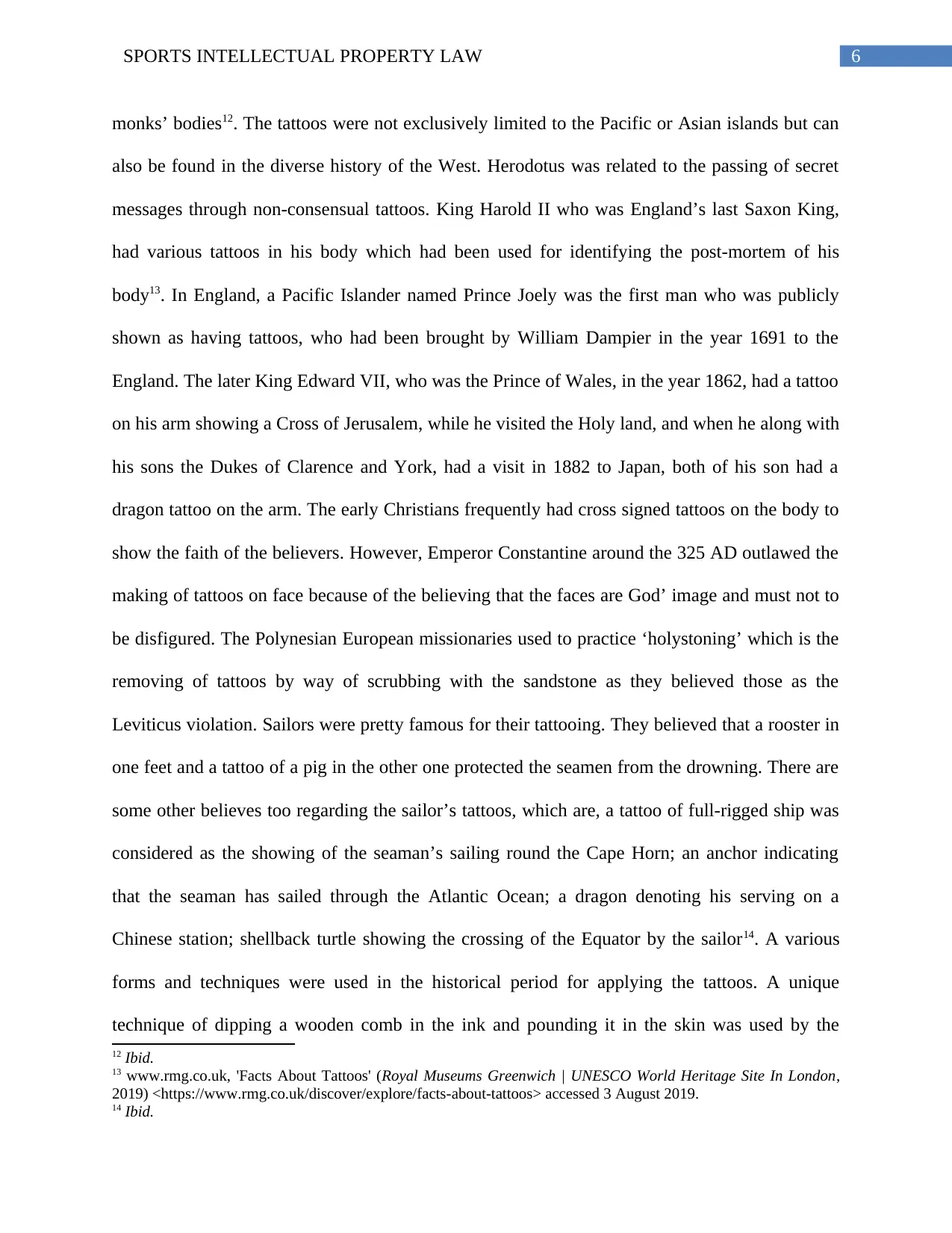
6SPORTS INTELLECTUAL PROPERTY LAW
monks’ bodies12. The tattoos were not exclusively limited to the Pacific or Asian islands but can
also be found in the diverse history of the West. Herodotus was related to the passing of secret
messages through non-consensual tattoos. King Harold II who was England’s last Saxon King,
had various tattoos in his body which had been used for identifying the post-mortem of his
body13. In England, a Pacific Islander named Prince Joely was the first man who was publicly
shown as having tattoos, who had been brought by William Dampier in the year 1691 to the
England. The later King Edward VII, who was the Prince of Wales, in the year 1862, had a tattoo
on his arm showing a Cross of Jerusalem, while he visited the Holy land, and when he along with
his sons the Dukes of Clarence and York, had a visit in 1882 to Japan, both of his son had a
dragon tattoo on the arm. The early Christians frequently had cross signed tattoos on the body to
show the faith of the believers. However, Emperor Constantine around the 325 AD outlawed the
making of tattoos on face because of the believing that the faces are God’ image and must not to
be disfigured. The Polynesian European missionaries used to practice ‘holystoning’ which is the
removing of tattoos by way of scrubbing with the sandstone as they believed those as the
Leviticus violation. Sailors were pretty famous for their tattooing. They believed that a rooster in
one feet and a tattoo of a pig in the other one protected the seamen from the drowning. There are
some other believes too regarding the sailor’s tattoos, which are, a tattoo of full-rigged ship was
considered as the showing of the seaman’s sailing round the Cape Horn; an anchor indicating
that the seaman has sailed through the Atlantic Ocean; a dragon denoting his serving on a
Chinese station; shellback turtle showing the crossing of the Equator by the sailor14. A various
forms and techniques were used in the historical period for applying the tattoos. A unique
technique of dipping a wooden comb in the ink and pounding it in the skin was used by the
12 Ibid.
13 www.rmg.co.uk, 'Facts About Tattoos' (Royal Museums Greenwich | UNESCO World Heritage Site In London,
2019) <https://www.rmg.co.uk/discover/explore/facts-about-tattoos> accessed 3 August 2019.
14 Ibid.
monks’ bodies12. The tattoos were not exclusively limited to the Pacific or Asian islands but can
also be found in the diverse history of the West. Herodotus was related to the passing of secret
messages through non-consensual tattoos. King Harold II who was England’s last Saxon King,
had various tattoos in his body which had been used for identifying the post-mortem of his
body13. In England, a Pacific Islander named Prince Joely was the first man who was publicly
shown as having tattoos, who had been brought by William Dampier in the year 1691 to the
England. The later King Edward VII, who was the Prince of Wales, in the year 1862, had a tattoo
on his arm showing a Cross of Jerusalem, while he visited the Holy land, and when he along with
his sons the Dukes of Clarence and York, had a visit in 1882 to Japan, both of his son had a
dragon tattoo on the arm. The early Christians frequently had cross signed tattoos on the body to
show the faith of the believers. However, Emperor Constantine around the 325 AD outlawed the
making of tattoos on face because of the believing that the faces are God’ image and must not to
be disfigured. The Polynesian European missionaries used to practice ‘holystoning’ which is the
removing of tattoos by way of scrubbing with the sandstone as they believed those as the
Leviticus violation. Sailors were pretty famous for their tattooing. They believed that a rooster in
one feet and a tattoo of a pig in the other one protected the seamen from the drowning. There are
some other believes too regarding the sailor’s tattoos, which are, a tattoo of full-rigged ship was
considered as the showing of the seaman’s sailing round the Cape Horn; an anchor indicating
that the seaman has sailed through the Atlantic Ocean; a dragon denoting his serving on a
Chinese station; shellback turtle showing the crossing of the Equator by the sailor14. A various
forms and techniques were used in the historical period for applying the tattoos. A unique
technique of dipping a wooden comb in the ink and pounding it in the skin was used by the
12 Ibid.
13 www.rmg.co.uk, 'Facts About Tattoos' (Royal Museums Greenwich | UNESCO World Heritage Site In London,
2019) <https://www.rmg.co.uk/discover/explore/facts-about-tattoos> accessed 3 August 2019.
14 Ibid.
Paraphrase This Document
Need a fresh take? Get an instant paraphrase of this document with our AI Paraphraser
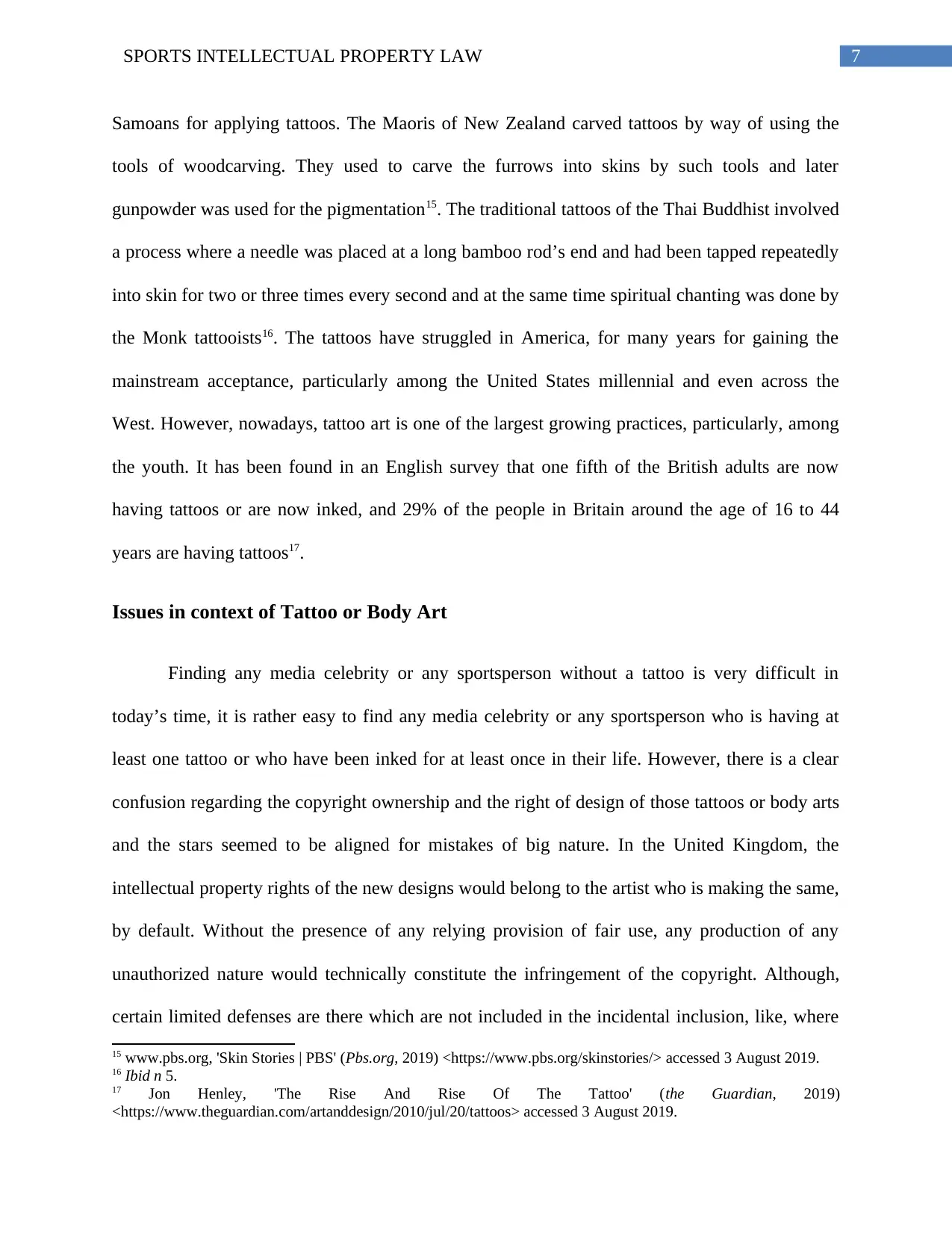
7SPORTS INTELLECTUAL PROPERTY LAW
Samoans for applying tattoos. The Maoris of New Zealand carved tattoos by way of using the
tools of woodcarving. They used to carve the furrows into skins by such tools and later
gunpowder was used for the pigmentation15. The traditional tattoos of the Thai Buddhist involved
a process where a needle was placed at a long bamboo rod’s end and had been tapped repeatedly
into skin for two or three times every second and at the same time spiritual chanting was done by
the Monk tattooists16. The tattoos have struggled in America, for many years for gaining the
mainstream acceptance, particularly among the United States millennial and even across the
West. However, nowadays, tattoo art is one of the largest growing practices, particularly, among
the youth. It has been found in an English survey that one fifth of the British adults are now
having tattoos or are now inked, and 29% of the people in Britain around the age of 16 to 44
years are having tattoos17.
Issues in context of Tattoo or Body Art
Finding any media celebrity or any sportsperson without a tattoo is very difficult in
today’s time, it is rather easy to find any media celebrity or any sportsperson who is having at
least one tattoo or who have been inked for at least once in their life. However, there is a clear
confusion regarding the copyright ownership and the right of design of those tattoos or body arts
and the stars seemed to be aligned for mistakes of big nature. In the United Kingdom, the
intellectual property rights of the new designs would belong to the artist who is making the same,
by default. Without the presence of any relying provision of fair use, any production of any
unauthorized nature would technically constitute the infringement of the copyright. Although,
certain limited defenses are there which are not included in the incidental inclusion, like, where
15 www.pbs.org, 'Skin Stories | PBS' (Pbs.org, 2019) <https://www.pbs.org/skinstories/> accessed 3 August 2019.
16 Ibid n 5.
17 Jon Henley, 'The Rise And Rise Of The Tattoo' (the Guardian, 2019)
<https://www.theguardian.com/artanddesign/2010/jul/20/tattoos> accessed 3 August 2019.
Samoans for applying tattoos. The Maoris of New Zealand carved tattoos by way of using the
tools of woodcarving. They used to carve the furrows into skins by such tools and later
gunpowder was used for the pigmentation15. The traditional tattoos of the Thai Buddhist involved
a process where a needle was placed at a long bamboo rod’s end and had been tapped repeatedly
into skin for two or three times every second and at the same time spiritual chanting was done by
the Monk tattooists16. The tattoos have struggled in America, for many years for gaining the
mainstream acceptance, particularly among the United States millennial and even across the
West. However, nowadays, tattoo art is one of the largest growing practices, particularly, among
the youth. It has been found in an English survey that one fifth of the British adults are now
having tattoos or are now inked, and 29% of the people in Britain around the age of 16 to 44
years are having tattoos17.
Issues in context of Tattoo or Body Art
Finding any media celebrity or any sportsperson without a tattoo is very difficult in
today’s time, it is rather easy to find any media celebrity or any sportsperson who is having at
least one tattoo or who have been inked for at least once in their life. However, there is a clear
confusion regarding the copyright ownership and the right of design of those tattoos or body arts
and the stars seemed to be aligned for mistakes of big nature. In the United Kingdom, the
intellectual property rights of the new designs would belong to the artist who is making the same,
by default. Without the presence of any relying provision of fair use, any production of any
unauthorized nature would technically constitute the infringement of the copyright. Although,
certain limited defenses are there which are not included in the incidental inclusion, like, where
15 www.pbs.org, 'Skin Stories | PBS' (Pbs.org, 2019) <https://www.pbs.org/skinstories/> accessed 3 August 2019.
16 Ibid n 5.
17 Jon Henley, 'The Rise And Rise Of The Tattoo' (the Guardian, 2019)
<https://www.theguardian.com/artanddesign/2010/jul/20/tattoos> accessed 3 August 2019.
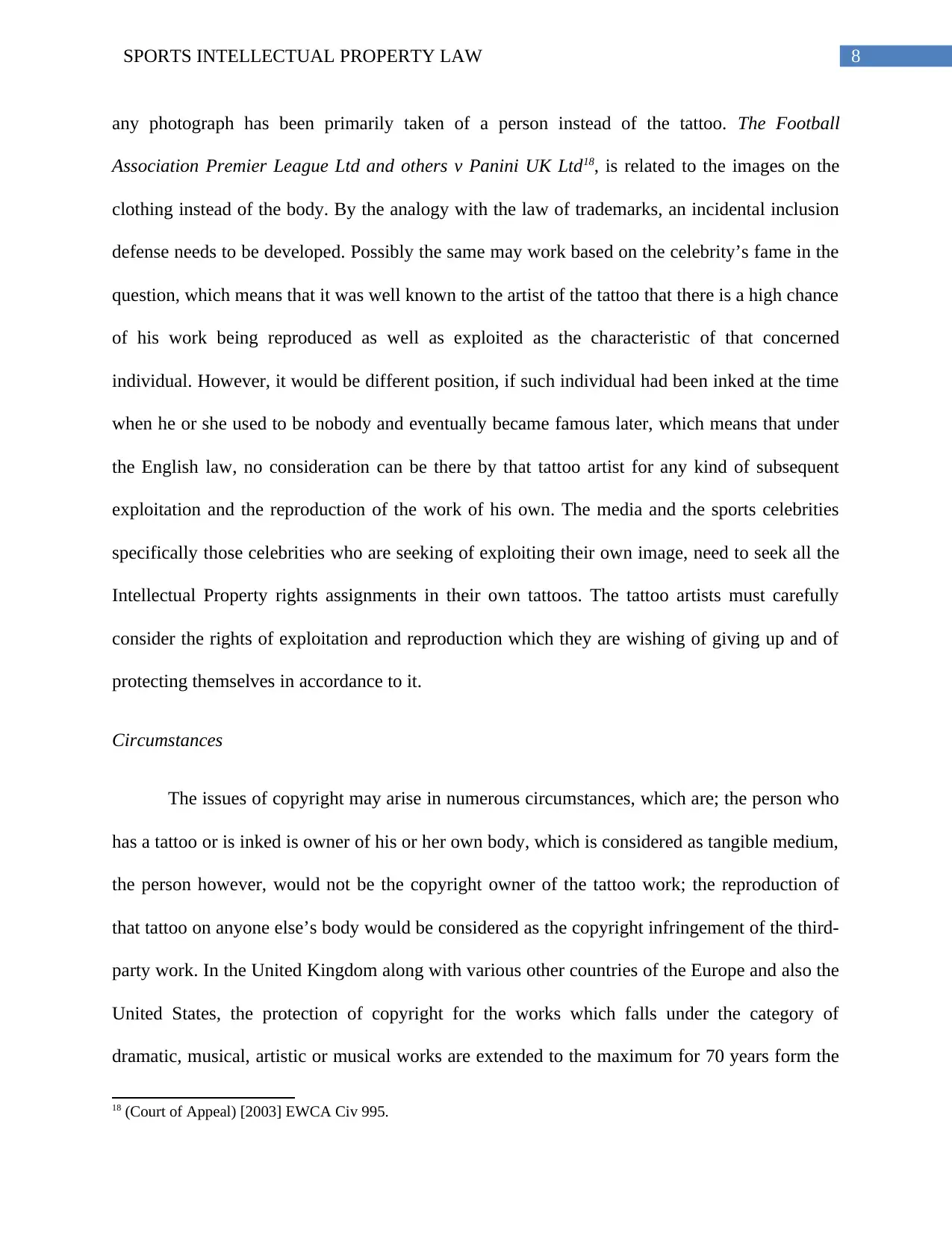
8SPORTS INTELLECTUAL PROPERTY LAW
any photograph has been primarily taken of a person instead of the tattoo. The Football
Association Premier League Ltd and others v Panini UK Ltd18, is related to the images on the
clothing instead of the body. By the analogy with the law of trademarks, an incidental inclusion
defense needs to be developed. Possibly the same may work based on the celebrity’s fame in the
question, which means that it was well known to the artist of the tattoo that there is a high chance
of his work being reproduced as well as exploited as the characteristic of that concerned
individual. However, it would be different position, if such individual had been inked at the time
when he or she used to be nobody and eventually became famous later, which means that under
the English law, no consideration can be there by that tattoo artist for any kind of subsequent
exploitation and the reproduction of the work of his own. The media and the sports celebrities
specifically those celebrities who are seeking of exploiting their own image, need to seek all the
Intellectual Property rights assignments in their own tattoos. The tattoo artists must carefully
consider the rights of exploitation and reproduction which they are wishing of giving up and of
protecting themselves in accordance to it.
Circumstances
The issues of copyright may arise in numerous circumstances, which are; the person who
has a tattoo or is inked is owner of his or her own body, which is considered as tangible medium,
the person however, would not be the copyright owner of the tattoo work; the reproduction of
that tattoo on anyone else’s body would be considered as the copyright infringement of the third-
party work. In the United Kingdom along with various other countries of the Europe and also the
United States, the protection of copyright for the works which falls under the category of
dramatic, musical, artistic or musical works are extended to the maximum for 70 years form the
18 (Court of Appeal) [2003] EWCA Civ 995.
any photograph has been primarily taken of a person instead of the tattoo. The Football
Association Premier League Ltd and others v Panini UK Ltd18, is related to the images on the
clothing instead of the body. By the analogy with the law of trademarks, an incidental inclusion
defense needs to be developed. Possibly the same may work based on the celebrity’s fame in the
question, which means that it was well known to the artist of the tattoo that there is a high chance
of his work being reproduced as well as exploited as the characteristic of that concerned
individual. However, it would be different position, if such individual had been inked at the time
when he or she used to be nobody and eventually became famous later, which means that under
the English law, no consideration can be there by that tattoo artist for any kind of subsequent
exploitation and the reproduction of the work of his own. The media and the sports celebrities
specifically those celebrities who are seeking of exploiting their own image, need to seek all the
Intellectual Property rights assignments in their own tattoos. The tattoo artists must carefully
consider the rights of exploitation and reproduction which they are wishing of giving up and of
protecting themselves in accordance to it.
Circumstances
The issues of copyright may arise in numerous circumstances, which are; the person who
has a tattoo or is inked is owner of his or her own body, which is considered as tangible medium,
the person however, would not be the copyright owner of the tattoo work; the reproduction of
that tattoo on anyone else’s body would be considered as the copyright infringement of the third-
party work. In the United Kingdom along with various other countries of the Europe and also the
United States, the protection of copyright for the works which falls under the category of
dramatic, musical, artistic or musical works are extended to the maximum for 70 years form the
18 (Court of Appeal) [2003] EWCA Civ 995.
⊘ This is a preview!⊘
Do you want full access?
Subscribe today to unlock all pages.

Trusted by 1+ million students worldwide
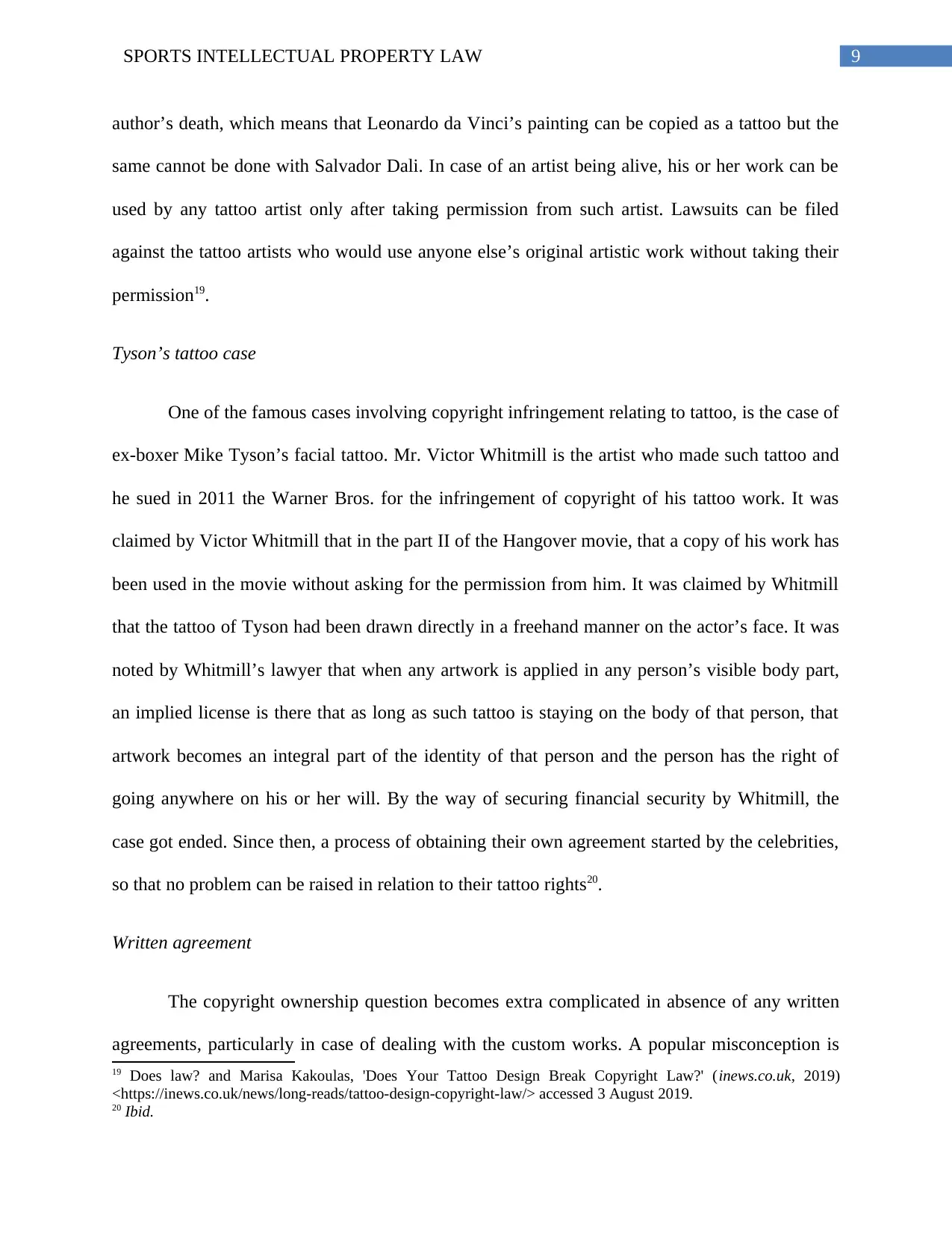
9SPORTS INTELLECTUAL PROPERTY LAW
author’s death, which means that Leonardo da Vinci’s painting can be copied as a tattoo but the
same cannot be done with Salvador Dali. In case of an artist being alive, his or her work can be
used by any tattoo artist only after taking permission from such artist. Lawsuits can be filed
against the tattoo artists who would use anyone else’s original artistic work without taking their
permission19.
Tyson’s tattoo case
One of the famous cases involving copyright infringement relating to tattoo, is the case of
ex-boxer Mike Tyson’s facial tattoo. Mr. Victor Whitmill is the artist who made such tattoo and
he sued in 2011 the Warner Bros. for the infringement of copyright of his tattoo work. It was
claimed by Victor Whitmill that in the part II of the Hangover movie, that a copy of his work has
been used in the movie without asking for the permission from him. It was claimed by Whitmill
that the tattoo of Tyson had been drawn directly in a freehand manner on the actor’s face. It was
noted by Whitmill’s lawyer that when any artwork is applied in any person’s visible body part,
an implied license is there that as long as such tattoo is staying on the body of that person, that
artwork becomes an integral part of the identity of that person and the person has the right of
going anywhere on his or her will. By the way of securing financial security by Whitmill, the
case got ended. Since then, a process of obtaining their own agreement started by the celebrities,
so that no problem can be raised in relation to their tattoo rights20.
Written agreement
The copyright ownership question becomes extra complicated in absence of any written
agreements, particularly in case of dealing with the custom works. A popular misconception is
19 Does law? and Marisa Kakoulas, 'Does Your Tattoo Design Break Copyright Law?' (inews.co.uk, 2019)
<https://inews.co.uk/news/long-reads/tattoo-design-copyright-law/> accessed 3 August 2019.
20 Ibid.
author’s death, which means that Leonardo da Vinci’s painting can be copied as a tattoo but the
same cannot be done with Salvador Dali. In case of an artist being alive, his or her work can be
used by any tattoo artist only after taking permission from such artist. Lawsuits can be filed
against the tattoo artists who would use anyone else’s original artistic work without taking their
permission19.
Tyson’s tattoo case
One of the famous cases involving copyright infringement relating to tattoo, is the case of
ex-boxer Mike Tyson’s facial tattoo. Mr. Victor Whitmill is the artist who made such tattoo and
he sued in 2011 the Warner Bros. for the infringement of copyright of his tattoo work. It was
claimed by Victor Whitmill that in the part II of the Hangover movie, that a copy of his work has
been used in the movie without asking for the permission from him. It was claimed by Whitmill
that the tattoo of Tyson had been drawn directly in a freehand manner on the actor’s face. It was
noted by Whitmill’s lawyer that when any artwork is applied in any person’s visible body part,
an implied license is there that as long as such tattoo is staying on the body of that person, that
artwork becomes an integral part of the identity of that person and the person has the right of
going anywhere on his or her will. By the way of securing financial security by Whitmill, the
case got ended. Since then, a process of obtaining their own agreement started by the celebrities,
so that no problem can be raised in relation to their tattoo rights20.
Written agreement
The copyright ownership question becomes extra complicated in absence of any written
agreements, particularly in case of dealing with the custom works. A popular misconception is
19 Does law? and Marisa Kakoulas, 'Does Your Tattoo Design Break Copyright Law?' (inews.co.uk, 2019)
<https://inews.co.uk/news/long-reads/tattoo-design-copyright-law/> accessed 3 August 2019.
20 Ibid.
Paraphrase This Document
Need a fresh take? Get an instant paraphrase of this document with our AI Paraphraser
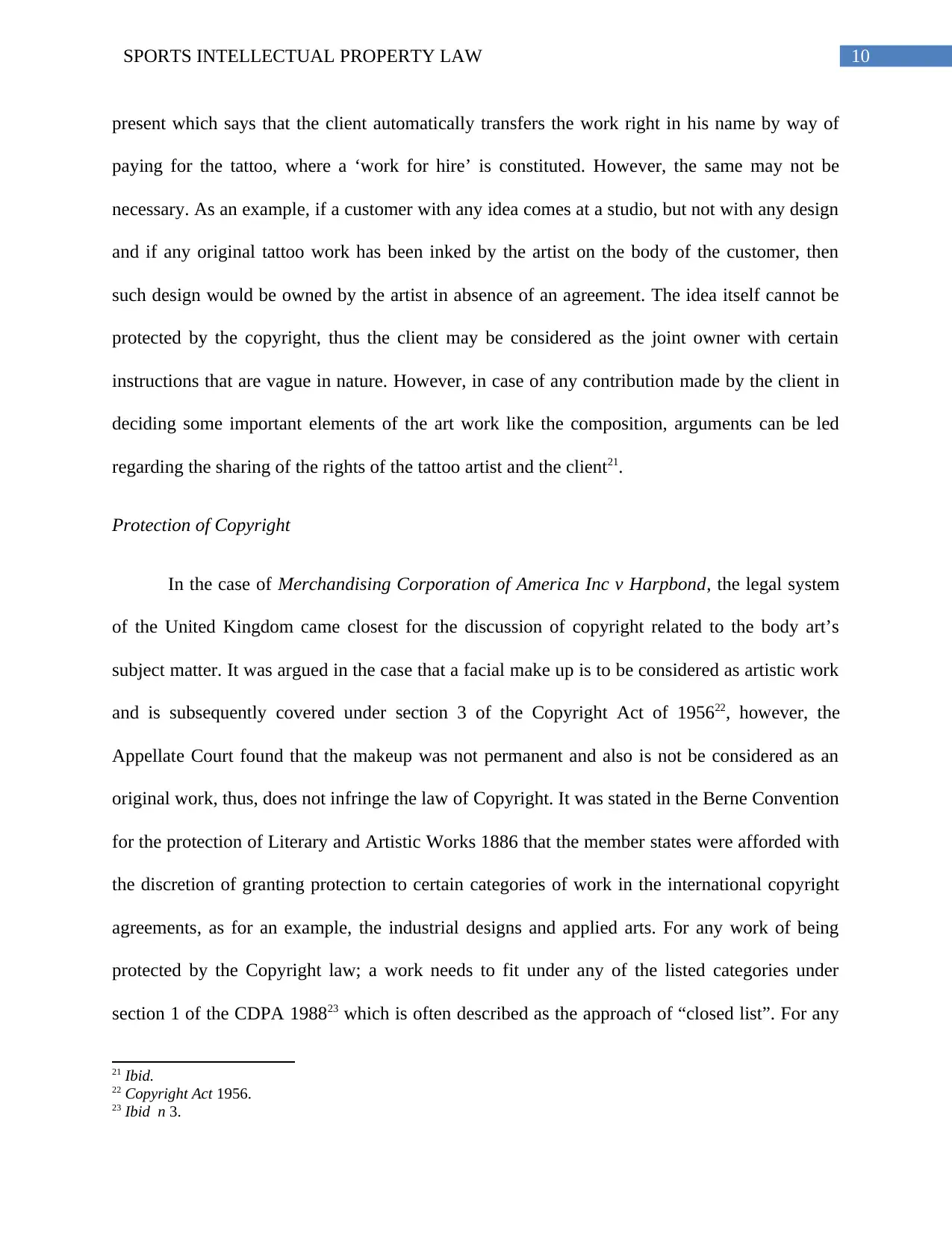
10SPORTS INTELLECTUAL PROPERTY LAW
present which says that the client automatically transfers the work right in his name by way of
paying for the tattoo, where a ‘work for hire’ is constituted. However, the same may not be
necessary. As an example, if a customer with any idea comes at a studio, but not with any design
and if any original tattoo work has been inked by the artist on the body of the customer, then
such design would be owned by the artist in absence of an agreement. The idea itself cannot be
protected by the copyright, thus the client may be considered as the joint owner with certain
instructions that are vague in nature. However, in case of any contribution made by the client in
deciding some important elements of the art work like the composition, arguments can be led
regarding the sharing of the rights of the tattoo artist and the client21.
Protection of Copyright
In the case of Merchandising Corporation of America Inc v Harpbond, the legal system
of the United Kingdom came closest for the discussion of copyright related to the body art’s
subject matter. It was argued in the case that a facial make up is to be considered as artistic work
and is subsequently covered under section 3 of the Copyright Act of 195622, however, the
Appellate Court found that the makeup was not permanent and also is not be considered as an
original work, thus, does not infringe the law of Copyright. It was stated in the Berne Convention
for the protection of Literary and Artistic Works 1886 that the member states were afforded with
the discretion of granting protection to certain categories of work in the international copyright
agreements, as for an example, the industrial designs and applied arts. For any work of being
protected by the Copyright law; a work needs to fit under any of the listed categories under
section 1 of the CDPA 198823 which is often described as the approach of “closed list”. For any
21 Ibid.
22 Copyright Act 1956.
23 Ibid n 3.
present which says that the client automatically transfers the work right in his name by way of
paying for the tattoo, where a ‘work for hire’ is constituted. However, the same may not be
necessary. As an example, if a customer with any idea comes at a studio, but not with any design
and if any original tattoo work has been inked by the artist on the body of the customer, then
such design would be owned by the artist in absence of an agreement. The idea itself cannot be
protected by the copyright, thus the client may be considered as the joint owner with certain
instructions that are vague in nature. However, in case of any contribution made by the client in
deciding some important elements of the art work like the composition, arguments can be led
regarding the sharing of the rights of the tattoo artist and the client21.
Protection of Copyright
In the case of Merchandising Corporation of America Inc v Harpbond, the legal system
of the United Kingdom came closest for the discussion of copyright related to the body art’s
subject matter. It was argued in the case that a facial make up is to be considered as artistic work
and is subsequently covered under section 3 of the Copyright Act of 195622, however, the
Appellate Court found that the makeup was not permanent and also is not be considered as an
original work, thus, does not infringe the law of Copyright. It was stated in the Berne Convention
for the protection of Literary and Artistic Works 1886 that the member states were afforded with
the discretion of granting protection to certain categories of work in the international copyright
agreements, as for an example, the industrial designs and applied arts. For any work of being
protected by the Copyright law; a work needs to fit under any of the listed categories under
section 1 of the CDPA 198823 which is often described as the approach of “closed list”. For any
21 Ibid.
22 Copyright Act 1956.
23 Ibid n 3.
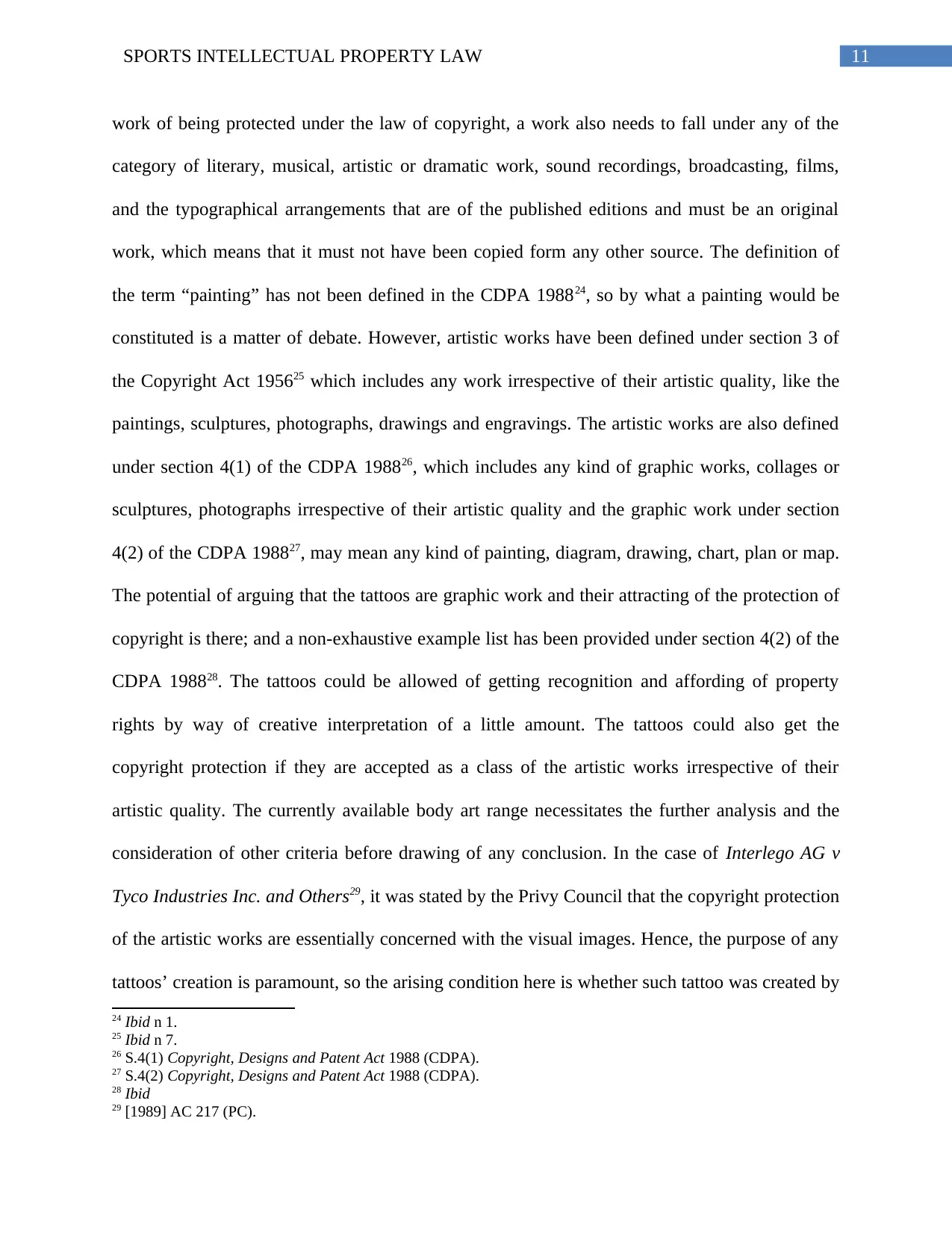
11SPORTS INTELLECTUAL PROPERTY LAW
work of being protected under the law of copyright, a work also needs to fall under any of the
category of literary, musical, artistic or dramatic work, sound recordings, broadcasting, films,
and the typographical arrangements that are of the published editions and must be an original
work, which means that it must not have been copied form any other source. The definition of
the term “painting” has not been defined in the CDPA 198824, so by what a painting would be
constituted is a matter of debate. However, artistic works have been defined under section 3 of
the Copyright Act 195625 which includes any work irrespective of their artistic quality, like the
paintings, sculptures, photographs, drawings and engravings. The artistic works are also defined
under section 4(1) of the CDPA 198826, which includes any kind of graphic works, collages or
sculptures, photographs irrespective of their artistic quality and the graphic work under section
4(2) of the CDPA 198827, may mean any kind of painting, diagram, drawing, chart, plan or map.
The potential of arguing that the tattoos are graphic work and their attracting of the protection of
copyright is there; and a non-exhaustive example list has been provided under section 4(2) of the
CDPA 198828. The tattoos could be allowed of getting recognition and affording of property
rights by way of creative interpretation of a little amount. The tattoos could also get the
copyright protection if they are accepted as a class of the artistic works irrespective of their
artistic quality. The currently available body art range necessitates the further analysis and the
consideration of other criteria before drawing of any conclusion. In the case of Interlego AG v
Tyco Industries Inc. and Others29, it was stated by the Privy Council that the copyright protection
of the artistic works are essentially concerned with the visual images. Hence, the purpose of any
tattoos’ creation is paramount, so the arising condition here is whether such tattoo was created by
24 Ibid n 1.
25 Ibid n 7.
26 S.4(1) Copyright, Designs and Patent Act 1988 (CDPA).
27 S.4(2) Copyright, Designs and Patent Act 1988 (CDPA).
28 Ibid
29 [1989] AC 217 (PC).
work of being protected under the law of copyright, a work also needs to fall under any of the
category of literary, musical, artistic or dramatic work, sound recordings, broadcasting, films,
and the typographical arrangements that are of the published editions and must be an original
work, which means that it must not have been copied form any other source. The definition of
the term “painting” has not been defined in the CDPA 198824, so by what a painting would be
constituted is a matter of debate. However, artistic works have been defined under section 3 of
the Copyright Act 195625 which includes any work irrespective of their artistic quality, like the
paintings, sculptures, photographs, drawings and engravings. The artistic works are also defined
under section 4(1) of the CDPA 198826, which includes any kind of graphic works, collages or
sculptures, photographs irrespective of their artistic quality and the graphic work under section
4(2) of the CDPA 198827, may mean any kind of painting, diagram, drawing, chart, plan or map.
The potential of arguing that the tattoos are graphic work and their attracting of the protection of
copyright is there; and a non-exhaustive example list has been provided under section 4(2) of the
CDPA 198828. The tattoos could be allowed of getting recognition and affording of property
rights by way of creative interpretation of a little amount. The tattoos could also get the
copyright protection if they are accepted as a class of the artistic works irrespective of their
artistic quality. The currently available body art range necessitates the further analysis and the
consideration of other criteria before drawing of any conclusion. In the case of Interlego AG v
Tyco Industries Inc. and Others29, it was stated by the Privy Council that the copyright protection
of the artistic works are essentially concerned with the visual images. Hence, the purpose of any
tattoos’ creation is paramount, so the arising condition here is whether such tattoo was created by
24 Ibid n 1.
25 Ibid n 7.
26 S.4(1) Copyright, Designs and Patent Act 1988 (CDPA).
27 S.4(2) Copyright, Designs and Patent Act 1988 (CDPA).
28 Ibid
29 [1989] AC 217 (PC).
⊘ This is a preview!⊘
Do you want full access?
Subscribe today to unlock all pages.

Trusted by 1+ million students worldwide
1 out of 20
Related Documents
Your All-in-One AI-Powered Toolkit for Academic Success.
+13062052269
info@desklib.com
Available 24*7 on WhatsApp / Email
![[object Object]](/_next/static/media/star-bottom.7253800d.svg)
Unlock your academic potential
Copyright © 2020–2025 A2Z Services. All Rights Reserved. Developed and managed by ZUCOL.





